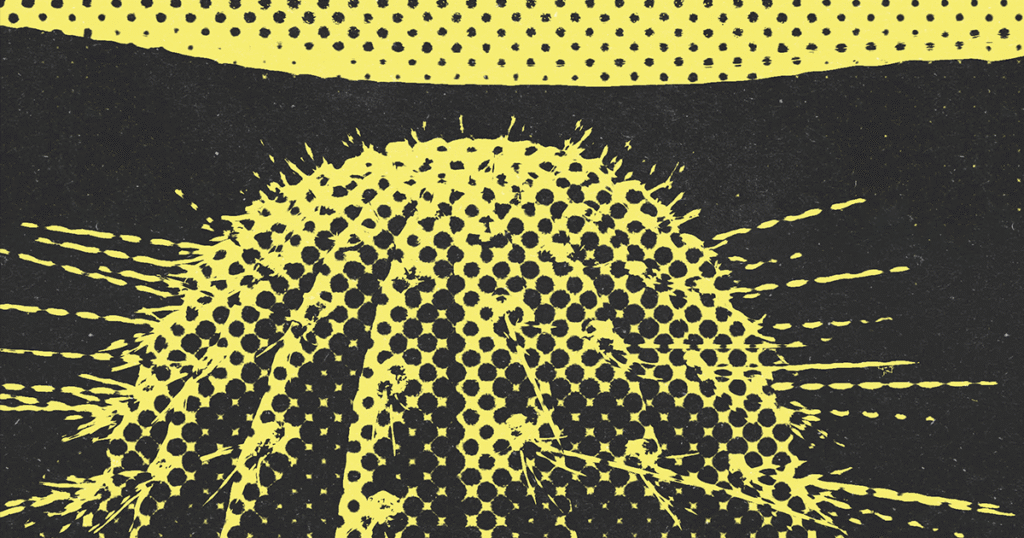
Can design kill the world?
- Opinion
Introduction
I would have loved to have a lighthearted chat with you, talking about all things design, and how the weather was beautiful, autumn leaves bringing a colorful twist to the impressive industrial architectures of the venues… But, can you nowadays talk about a warm, sunny day at the brink of winter in the Netherlands without a thought to climate change? Can you cheerfully go on with your day mesmerized by beautiful new designs and not antagonize innovative industry with the failing of nature, dragging humanity in it’s wake? Can culture really save us or will it serve as a pretext for deception?
Last October, Cédric and I, members of Humanitarian Designers, travelled to Eindhoven to visit the Dutch Design Week 2024. As an individual, I had a lovely time full of inspiring conversations, exalting discoveries and uplifting stimulations. A designer’s paradise. As an intersectional activist, I cannot evade the critical questioning brought on by such an event.
SUSTAINABLE FUTURE
From sustainable, to circular, to actual change
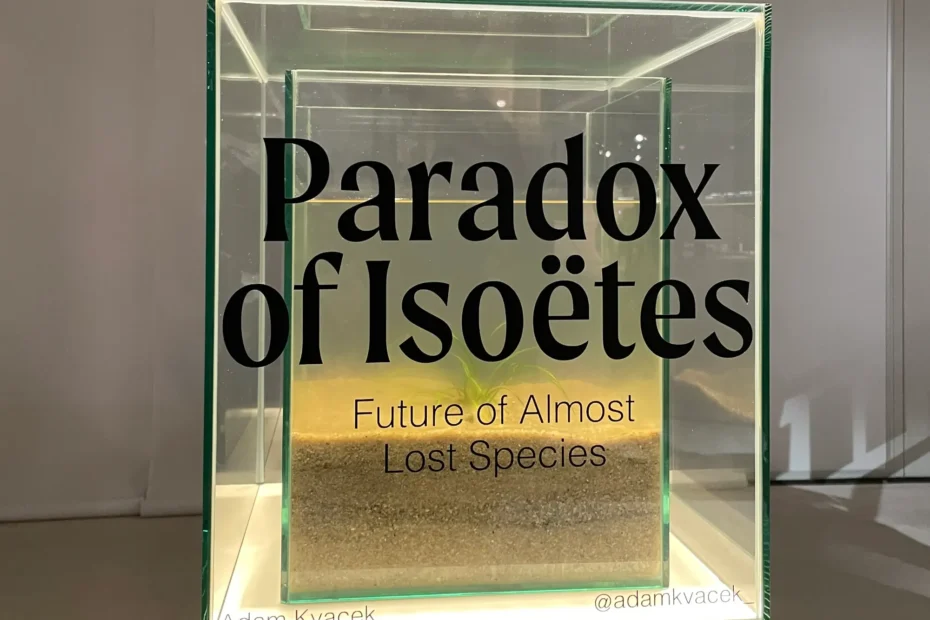
Designers are optimistic creatures: creative minds filled with a humane passion for problem solving, they look to the future with the wish of leaving their positive imprint on the world. “Shaping the future” is in all the talks, on all the walls. But as optimistic one may be, the future is now inherently associated with the climate crisis. From now on, one can’t reasonably speak of innovation without attaching “sustainable” as it’s indissociable shadow. Without sustainability there is no future.
Though it feels like stating the obvious, global industry has yet to integrate this into their economical calculations or even begin to care. Yet many design studios have now factored in “clean, renewable and green” in their production thinking processes. Some have even taken it a step further, transitioning “sustainable design” into “circular design”. More than a trend or an outstanding feature, at the DDW it seemed to have enmeshed most spaces as evident. Something to be optimistic about.
And then there are those who, above and beyond assimilating, made the idea of a greener future their actual goal. For some, quite literally: the project Respyre, cofounded by Auke Bleij and Adil Aarouss, humbly presented amongst a hundred others at the Microlab Hall, struck me as a possible game changer for our future. “Made from recycled cement, this material encourages spontaneous moss growth on urban surfaces”. Though my love for the brutalist aesthetics of cement is immense, I could breathe better just by reading the pitch of this project. These two designers put their engineering backgrounds (civil and chemistry) to work with the aim of inventing something that would actually make a difference. They brought scientific knowledge together with design practices as a process to climate change solutions.
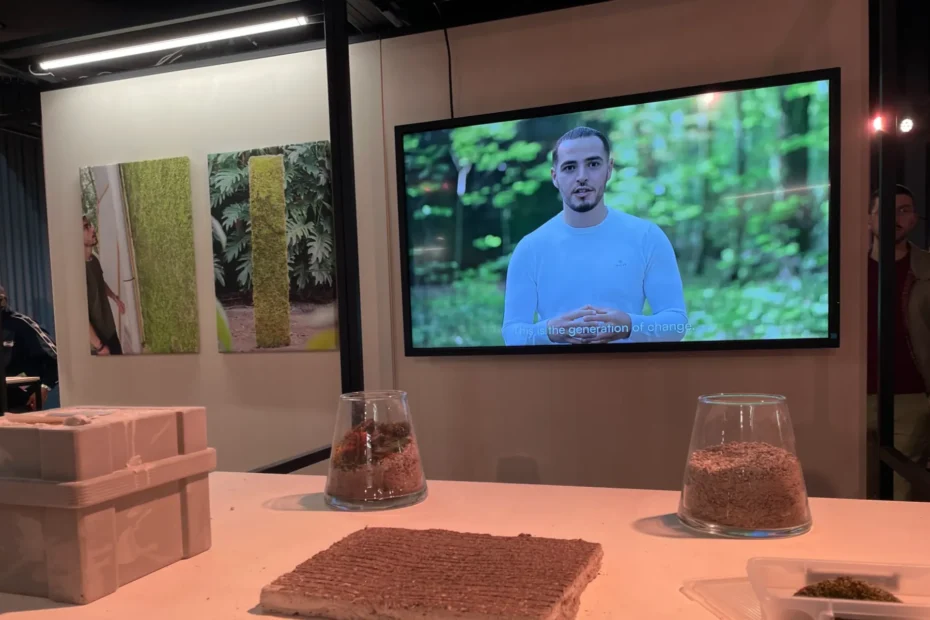
“Collaborations for Future”, enabled by Foundation We Are, made this process the foundation for their experiment. If there was just one exhibition to be seen at the DDW 2024, I would point to that one. In Collaborations for Future, “10 designers and 10 climate scientists collaborated 1 on 1, openly, for 9+ months. There was no assignment, goal, or roles given to the pairs.” The exhibition is the result of these collaborations. One of which was probably the most impacting experience for me this weekend: a simple vintage phone booth on a wall. If you dare pick up the phone, an actual climate scientist will answer and a conversation will start. So I gathered my curiosity to overcome my aversion of talking to strangers on the phone, and we talked. We talked about how the impact of this exhibition lay in the diversity of the propositions made by these collaborations. One was an end product complete with branding of a sea-water ice popsicle sold at the next door shop, made to make you reflect on the impact of sea-level rising. One produced the “10 climate commandments” to counter top-down approach of policymaking. One created an employee led movement to reduce KNMI Dutch Weather Institute’s own emissions to set an example for other organizations. One was an installation emphasizing how ancient knowledge, like the traditional Lebanese weather predictions made from observing a fig tree, can merge with the technology of a satellite… As I explained to my interlocutor how this one touched my heart and another touched my brain and yet a third triggered an emotional rejection reaction, we agreed how it might have been different for another visitor with a different sensibility. The cumulation of all of them has a better chance to reach any of us. We concluded that culture, brought on by an interdisciplinary process, is a vector for awareness that benefits all: the researchers as well as the observer. In the end, curiosity brings us together.
A chance encounter that day brought us to to converse with Kornelia Dimitrova and Bernhard Lenger, co-founders of Fondation We Are. We couldn’t help but make a parallel with Humanitarian Designers’ dedication to bring aid workers and designers together, specifically with our last project “Meetup Lab” held at CERN Ideasquare last September (link to our report). These connections sparked new ideas and hope of “future collaborations” between our two organizations.
HUMAN AND HUMANE
Together we make it better
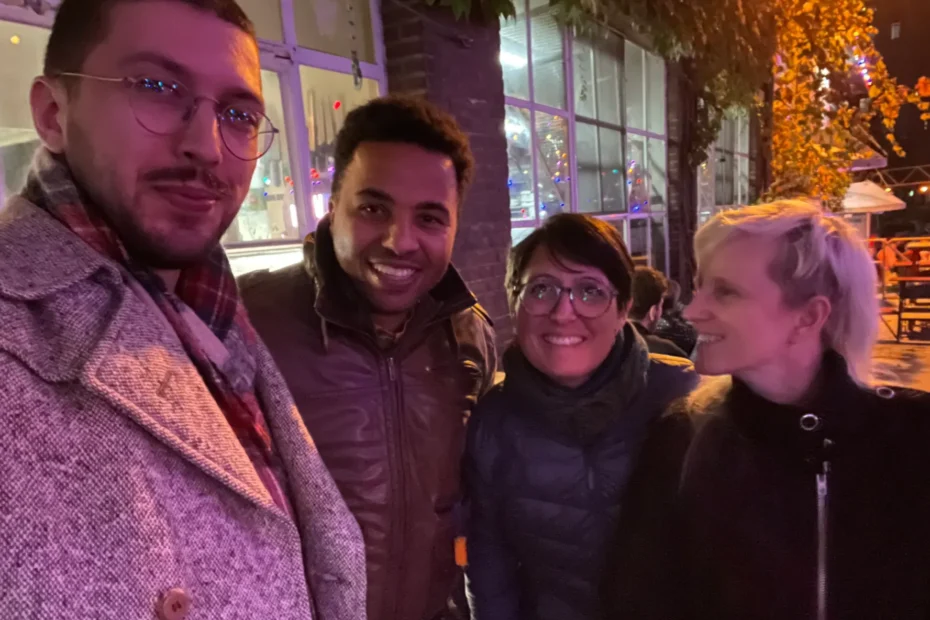
Another encounter made this weekend was organised with Cecilia, our very devoted advisor and core member of HD. She was there with Tiago Paes Vilas Boas, as co-founders of Design Reparations, proposing two workshops : “Celebrate and Preserve wisdoms and Heritage from Kenya” and “Engaging the Caribbean Diaspora through culture”. Though we weren’t able to attend these workshops, I wanted to convey here the essence of the captivating discussion we had with them while waiting for pizza: why do we do what we do when everything seems so bleak?
Unlike climate change at the heart of sustainable design, flying high with respectable colors made of green, social design does not benefit from the same staple positioning. Social design is the poor cousin of sustainable design for well meaning, impact thirsty designers. As “sustainable design” takes the cake, “social design” gets the crumbs.
Design Reparations is in a race against time: engaged in keeping ancestral knowledge alive in the younger design generations and bringing justice to past erasure through collaborations with indigenous wisdoms. It seems such a humbling yet endless task in a time when “decolonizing” is already an overused and depleted word, when Europe has yet to admit their part in conveniently robbing the African continent of their resources while imposing a fabricated debt. That mission feels like a task made for Sisyphus and our actions like a drop in the ocean. Yet, here we are, relentlessly fighting to give meaning back to “putting the humane at the center of design”. Here too, knowledge holders and designers combine to make something new emerge.
Another workshop, “Cross pollination” hosted by the aptly named Clownfish and Anemone organization proposed to “bridge the gap between social science and social design” bringing scientists with designers to “combine the participatory methods of design with the grounded approach of social sciences”. There again, the same wording, the same enthusiast narrative: together let’s make it better.
The more I write, the more I realize how the intersectionality of combining expertise and disciplines is the new black of design. The question remains : How can design be of use in areas that already own their systems and knowledge? Why would they need us? I see and hear designers claiming their added value through the proactive nature of their “best practices”. What makes them best? Or even just better? Just like every new generation wants to revolutionize the world, we egotistically believe that we are the key to the problems created by those who came before us… who had the exact same convictions. We have heard this before : can design save the world? My question is: are we not luring ourselves with well-meaning intentions, acting as bright decoys while the world goes on crumbling? Throughout my wanderings in the halls of the DDW, within the very official walls of Strijp-S, the chic gallery of Kazern, or within the creative halls of Manifestations, enthusiasm oozed like the smile of a real estate agent. What are we trying to sell? Are our earnest intentions sufficient to justify our pretensions or are we naively pushing a cultural imperialist agenda?
The politics of design
I was surprised to see at Manifestations Hall, a place of “art, tech, and fun” dedicated mostly to emerging talents, a product that has been on the market for years: the Sheltersuit. That suit is an embodiment of these dilemmas. First designed in 2014 by Bas Timmer, a then fashion student, the Sheltersuit is a sleeping bag attachable to a coat made of recycled tents. A product then intended to provide warmth and dryness to the houseless people in the Netherlands. The initiative is now a foundation, active worldwide to help refugees and victims of disaster and conflicts. On their website you can read: “Our products are not meant as a replacement for finding a home but as a supplement when there’s no other choice.” This statement shines a light on a not so old controversy.
When in 2016, What Design Can Do , an international organization accelerating social and climate design solutions, launched their government funded open competition “shelters for refugees challenge”, criticism pointed at how problematic it was to think a shelter as temporary : children are born, grow, and become adults in such shelters. Is the next best thing a tent? In the Netherlands, tents are prohibited outside campgrounds while, at the same time, the government cuts funding for asylum seeking centers on the pretext of stricter asylum policies. What level of hypocrisy is this? So when shelters are closed and tents are prohibited, there will be no more homelessness? Though they did not participate in this challenge, I wonder where the Sheltersuit fits in the hierarchy of shelter solutions. By stating the refugee crisis as “A global challenge too big for governments and NGO’s alone”, What Design Can Do proposed design as a free market solution to political and socio-economical problems. How that narrative fits with neoliberal European policy emergence is questionable. Design can solve a refugee’s problem, but it can’t solve a refugee crisis. We can’t point the Sheltersuit as wrong because it is fundamentally right to give people a chance to sleep warm and dry and live through one more day. But what refugees need isn’t a sleeping bag, it’s a space in our societies. You don’t fix a system with a product.
This was 8 years ago: just a year after the whole of Europe started realising the extent of the migration situation made visible by the 2015 events in Greece. Have we learned? Have we progressed? The Sheltersuit foundation and What Design Can Do may have evolved and integrated learnings from such a controversy, but it looks like the rest of us are still oblivious: I couldn’t help but cringe at the 2024 DDW poster showing a smiling brown man in a bright red Sheltersuit, lying down in what seemed to be a dark, cold, filthy corner of the city with a title that states: “Turning trash into shelter”. How can such a globally renowned event focused on design not catch the numerous problematics of such an image?
The main theme at Manifestations this year was “Invisibilities” and if you looked beyond the bright Sheltersuit, -meaning literally behind the exhibited Sheltersuit- you would find an exhibition called “Eye Opener”. Created by Ervaring Die Staat, this exhibitions brings to light testimonies of these people “who are roof and/or homeless and have to deal with poverty, exclusion or loneliness”. These messages of hope and resilience from people who, one day, might have had the use of a Sheltersuit, brought me to tears. My heart is sensible to the stories but my soul rages at the necessity of such a show: my brain questions the suitability of connecting design with savior angelism.
Earlier that day, a little side step from the hectic epicenter of activities took us to The Living Room. What The Living Room offers is a space where refugees waiting in the limbo of Dutch administration can access basic necessities but also access to what makes us more than surviving animals: human connection and creative development. Dutch language lessons, theater, bicycle repair workshop, clothing design, photography… are just some of the activities offered there. During the DDW, The Living Room opened their doors to the public as a project entitled “Unseen” echoing, in a humble yet effective manner, Manifestation’s “invisibilities”.“What if, as a person, you feel like you’re not allowed to exist? Through this art project, we shed light on the lives of undocumented refugees, bringing this group out of the shadows of society.” In a Middle-Eastern style living room showcasing their activities, you could share a soup or a tea with one of their actors. No innovation in the proposition, but so much of what design -and people- can really do, here, now.
Design should not replace institutions and not even begin to pretend to. But when institutions fail, should we, as humane designers, act? or should we, as responsible citizens, refuse to put our creative minds to work for exploitative systems by taking on their loads? DDW isn’t a protest or a platform for unheard voices, it’s a showcase. All in all, design isn’t about products or services, it’s about outcomes.
BEAUTIFUL
Creativity put to function
What if DDW wasn’t the place and time to measure impact and outcomes but a place to explore and dream? Maybe DDW isn’t just the showcase of what design does, but more so about what it wants to do. Handing out a licence to dream just for a week, could it be a playground, or a science fair, for experimental and conceptual approaches? A place where efficiency, feasibility, return, -and other economical considerations- were of no concern to unleash creative freedom? Mix in speculative ideas, craft skills, artificial intelligence, rational childishness, anything frivolous with an aim to be taken seriously… without the constraint of financial profit, and you might just have the ingredients for breakthrough innovation. Or even enlightenment.
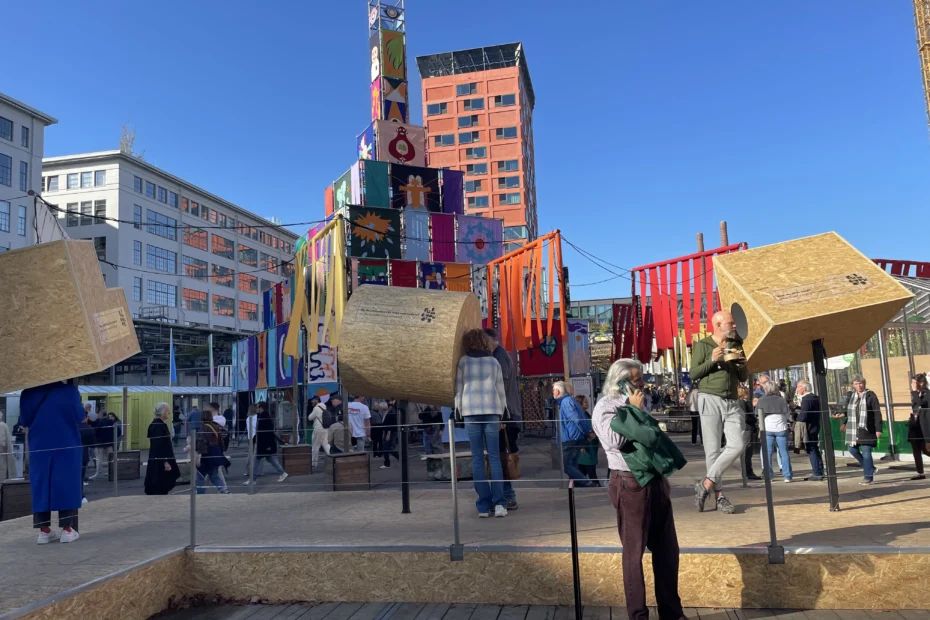
Miriam van der Lubbe, creative head of DDW, said “designers are uniquely capable of making the unimaginable imaginable”. DDW offers a fertile ground for expression and original thinking to trigger a sense of wonder but also to question the established truths. Design then becomes an art form which function isn’t to serve but to challenge.
Cédric and I have this ongoing conversation about the difference between art and design. I present myself as an artist, he presents as a designer. I came to the conclusion that “art asks questions, design answers questions”. Recently we came upon this citation “the function of art is to propose, not to satisfy” (La Séance De Marty). In that perspective one could wonder: in a world of needs what is the worth of beauty? the use for art? Beauty, more than aesthetics, encompasses meaning, emotions, solace, inspiration, harmony… It is what elevates people beyond being merely humans: food for the soul. On a scale of necessities, soul food is gravely underrated. Maslow himself never imagined needs in the form of a hierarchical pyramid but rather in terms of fluid interconnectedness. In that sense, design can answer the need for intellectual or emotional stimulation, transcending mere functionality to satisfy the human need for elevation through critical thinking and evaluation. Beauty isn’t always comfortable—it can also be transformative. As design should be.
In the end, what brings designers and artists together is bringing the abstract into reality.
Art design, Design art
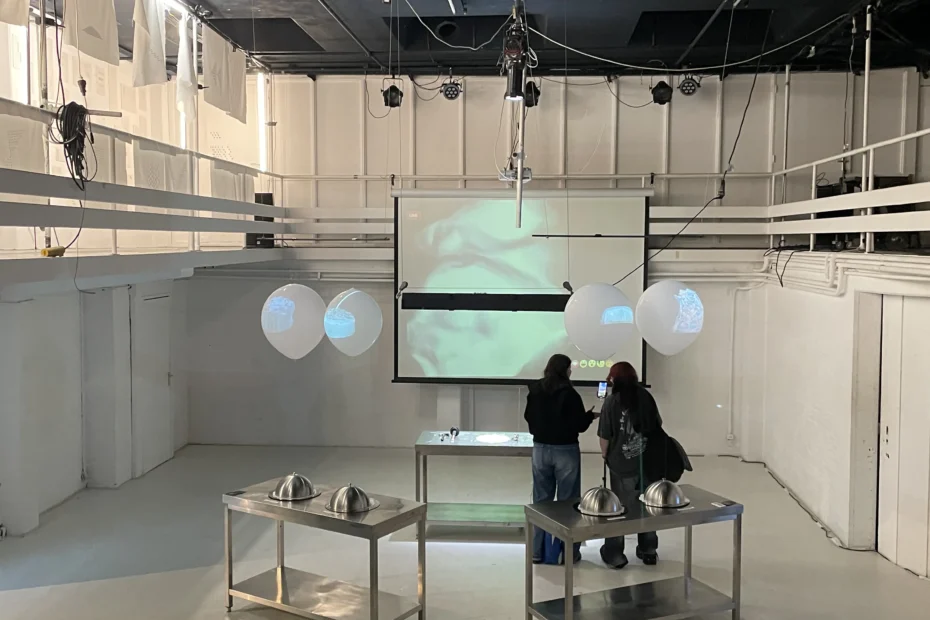
“Strategic design”, “fiction design”, “parametric design”, ”speculative design”, “disruptive design”, “information design”, … The programme section of the DDW website proposes filters to look for your favorite exhibitions. In the filter by disciplines, there were no less than 30 adjectives to choose from. Out of the 398 projects exhibited, 141 came out as “art design”.
As an artist in the middle of a design event, the visual art performer in me resonated deeply with the works presented in The Art House. The Art House, work place of the visual theater and dance company United Cowboys, is also a “creative production space for invited guest artists from various disciplines”. Upon passing the threshold of the house, I felt the soothing comfort of being at home. I could smell the broth of minds and bodies experimenting, cooking on a fireplace fueled by non-conventionality. Though more humble in size and means, this house is the epicenter of creative freedom in Eindhoven: a savage liberation of control in an otherwise very reasonable and conventional event. The Art House encourages artistic risk. Risk for the creators: to be vulnerable as a process, to find hidden truths, to not be understood and even rejected for shedding light on things that would rather stay hidden. Risk for the visitor: will you look into the eye of your own ugliness? As they embody their research, live artists hand out a mirror reflecting our humanity as a whole.
Though the house contained many meaningful works, two of them fit that purpose in a very unsettling manner: “Ten Year Sculptures” by Lotte Boonstra and “From the Bottom of My Heart” by Laura Papke. Presented in the same room, but separated by a black cloth, the two installations surprisingly collided into each other to form one powerful piece for me. On one side “Ten Year sculptures” made of mirrors and videos, displayed ten year old children, immersed in a weird universe of masses of matter and idleness.
On the other side a young women’s heartbeat is retransmitted on loud speakers while she repeats “I am standing here. You are watching me. I am not afraid”, over and over, as tension builds in her voice. While “Ten Year Sculpture” provided a set of earphones with it’s own soundtrack, the powerful sounds emanating from the other side of the room took over and I was subjugated by the mix of sounds and images fed to my senses. The hyper-sexualised charge of the sound made watching the childrens’ awkward behavior almost painful. My inner child screamed of the injustice I once felt: being observed as an object of desire I was not meant to be, thrown, powerless, into adult worlds. I was that woman desperate to keep the illusion of control in situations of helplessness, I was that child plunged into a mad world.
Later that day I was given the chance to witness the full performance “From the Bottom of my Heart” in the second part of the room. The fact that the young woman was half naked within arms reach of a dozen spectators did not add to what I had imagined as a fully clothed woman alone in a room with just one onlooker. The feeling of oppression and unsafeness as the clear message of the piece, did not come from numbers, proximity or nudity. It came from vulnerability. The live performance transcends this vulnerability as an empowering tool of expression.
In these controversial pieces, my hope is that the discomfort also reaches those who don’t relate to an endured experience but as part of the problem. Discomfort brings unexpected perspectives, “to be uncomfortable is to confront preconceptions and prejudice”. Challenging us to a learning opportunity, to grow into critical creators.
This is the moment where I would like to draw that fine line that links -and separates at the same time- the artist and the designer. An artists’ creation doesn’t necessarily need universality and owes no changes, return, or even an explanation. The artist is free, and is their own master. Yet, if they can question a system, criticize or praise a system, add beauty or feed the beast, they remain unable to change it. It is the designer’s duty. Engaging one’s body and mind autonomy into research is one thing: experiencing a thing is sometimes a necessary path to empathy, the designer’s claimed tool. At that stage, independence and mindfulness are keys to the grail of innovation and systemic change. But when comes the time of bringing the research into practice, an artist will step into the light as the singular manifestation of an unquestionable truth, while the designer should humbly set any individuality down to fade for the better good of their creation. In the end, the designers’ purpose is not beauty, it’s better good. Because of their role as capable impactors, at all times, designers should question their own processes and be able to recognize their biases, know their weight in the power balance. The artist shines when the designer serves. The ego in design is not welcome.
REALITY CHECK
Real Unreal
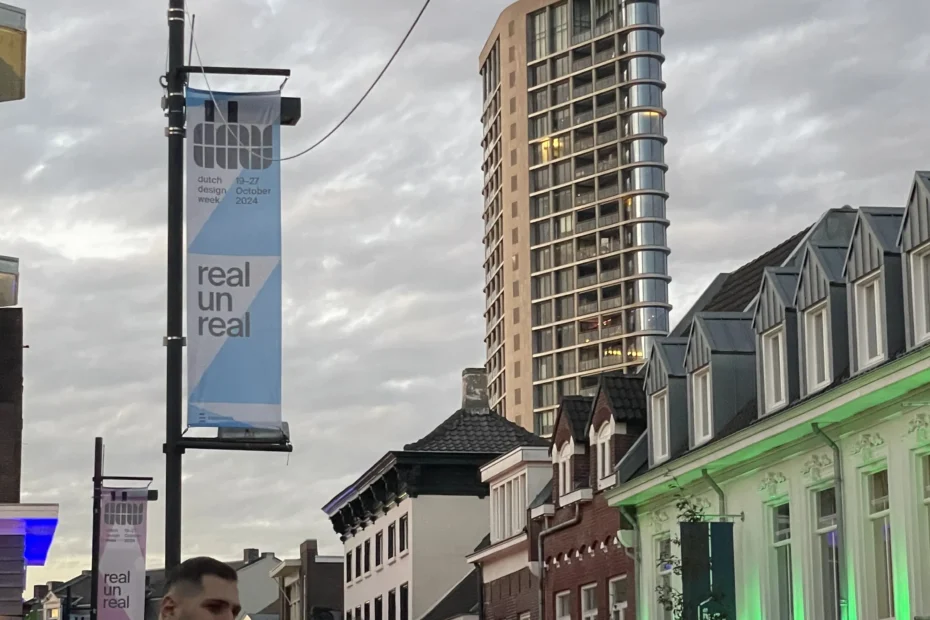
Back In 2012 the first Dutch Design Week theme was « Enter a Brave New World ». Though I am sure the reference to Huxley’s anticipation novel was not lost on us, the irony that it pointed to a dystopia might. Twelve years later, the theme of this year « Real Unreal » brings back the topic of fiction catching up on reality. The outskirts of what is known as real and true have now become somewhat blurry. As humanity expands into new realms should we be concerned or thrilled?
Systems
Manifestations Hall, one of the bigger venues of DDW, describes itself as “the festival of art and technology that celebrates digital activism through fun, wonder and curiosity”. (Note the absence of the word design). Many of the projects presented there deserved to be highlighted: Patrick van der Meij’s creation of Regulus 1, a frightful wooden sculpture presented as a satirical “one-stop solution in sustainable livestock management”; Flore Hanna Wormskamp’s installation Opsin, that lets us experience the octopus’ ability to perceive light with their whole bodies as a peek into the concept that humans are not the superior being they believe to be… For me, the minimalist installation of Growth by Abel Kamps and the unexpected plot twist that occurred during the DDW sums it all: a huge plastic bag full of water suspended over a cactus with heavy chains, a millimeter away from being pierced by the plant’s needles. In one visual statement, the artist questions the fragility of all systems, however robust, bound to die in time by it’s own nature. Things took an incredible turn when a visitor, unhooked the chains and unleashed the catastrophe that proved and killed the installation in a single action. The visitor’s candid excuse “we just came from the VR section, and everything there was interactive” proves ironically the consequences of virtual reality in the real world. The perfect illustration of the paradox: “man as the Creator and the Destroyer” being the first chapter of the exhibition, and the question that ensues “how deeply does technology determines your world thinking and acting?”. This is DDW 2024’s mandate: “don’t believe what you think”.
Somewhere in Eindhoven a huge mobile sign on wheels says “Fiction is Real” and if you look at it from a different perspective it says “Reality is fictional”. As I research online to understand, I stumble upon this very peculiar initiative “Outpost for Unreal Institutions” by Pete Ho Ching Fung and Samein Shamsher. For the first -and only- time in 3 days I read the word “capitalism”: “What institutions might we be missing to ensure a just and equitable transition away from capitalism?”. The installation is a speculation design “research outpost” that calls on collective imagination to dream up unreal institutions capable of change. Finally, someone has named the fundamental problem: “capitalism”. “Capitalism is flawed by design. You can’t solve a problem designed to “fail some so others can profit”, a system based on eternal expansion in a finite world… But, within the “fiction is real” outpost, you can start by imagining different systems. Cultivating them in a fictional space seems a reasonable environment and humble way to avoid harm. Yet what impact does fiction have on reality?
Following the “Fiction is Real” lead, my research online brings up another missed exhibition called “Fake Fiction” by the Fauxbia Collective. “Fake and real are far end spectrums in design that encompass and dictate value.” Though I can’t speak of their production having not seen it, their narrative shows a remarkable maturity of reflexion. “Fake Fiction explores fakeness as a conceptual lens to investigate and criticise the new and alternative realities of cultural and material production”. This collective of 8 designers from different parts of the world have pin pointed in a few sentences the actual problematic state of the art of design: the demiurge posture of the designer under the rule of mass production…
Go(o)d Design
As a creator, the designer gives an organized form to raw matter and sculpts chaos into purposeful shapes. Yet, designers don’t create ex nihilo, and work within constraints: what they produce is neither liberated, nor truly original. The very act of fabrication is a form of deception: manufacturing representations after representations, thus distancing their creation from the original truth. Wether independent or as servants of greater authority, they use their manipulative power within political, economical, religious, cultural frameworks to obtain beautiful and potentially deceptive outputs made to fit a pre-existing purpose. In a world where AI can generate entire identities, virtual environments can mimic physical presence, and deepfakes can alter history, the question shifts from “Is this real?” to “Who designed this reality?” Are designers revealing deeper truths, or simply refining the art of illusion? And at the end of it all: who does this new truth serve?
Let me share an experience I had in Strips-J hall when confronted with an AI named MAI: The exhibition “Meaningful Interactions with Virtual Humans” was hosted by Mindlabs. Cute girl, MAI was “trained” to interact with her interlocutors based on the emotions that facial features and expressions give away. A digital mentalist. As I approached with a very neutral face, MAI defined me as very sad and a bit angry. That made me sad and a bit angry. I am 48 years old, my forehead is barred with three lines called the Lions wrinkles, my eyelids don’t have the shape they used to have. As I experimented with the AI and gave myself a DIY momentary facelift just by pulling my skin back a little with my palms, MAI changed her tone and analysis of my inner emotions as more neutral and eventually “happy”. I was angry, angry at a non-human for having judged me on the years marking my face. Humans have built-in their ethical issues in biased facial recognition creations.
In the halls of Manifestations another cute AI girl, oddly also named MAI -after her own creator Maraya Ivanova– answers your questions. As she answers, 3 Liters of very real water are poured in front of your eyes. Thus bringing into reality the ecocidal impact of the water thirsty servers hidden behind these AI. To conclude, The MAI twins have different parents and therefore very different ambitions, in semblance of their creators. Though both are made with good intentions, one shows you the truth behind and the other makes its own truth, one knows it’s weaknesses and the other is blind to it. Which one will you trust your future with?
Real Unreal was not just a theme but a mirror to our time, revealing both the power and the peril of a world where design no longer just frames reality—it becomes it. Real unreal is no longer a paradox but an accepted paradigm. A few years ago, before algorithms shaped our reality bubbles, before pixels learned to impersonate matter, before machines mastered the art of lying with conviction, we used to shape the future from the present. Today, even the present with its infinite alternate realities has become difficult to encompass and handle. Are we past the warnings of a Brave New World? In an era where everything can be constructed, what do we choose to believe? The key takeaway here is the word “choose”. As creators working for a grander scheme our free will is now our most precious value. Over any algorithms’ incentive, we have the duty to interrogate our contribution responsibly and prioritise intellectual honesty over mystification, over ego.
CONCLUSION
As the colorful flags of DDW float for a week in Eindhoven’s blue sky, rows of anonymous characters, masked in white and dressed in the red of blood, parade silently carrying the Extinction Rebellion banner. A few meters away, another masked character, a grim reaper with a scythe, will take selfies with you in front of a planet covered in brands.
I see claims of innovation flourish all over the venues like a “free pass” for making and building things never seen or systems never experienced and I can’t help but link that mindset with one of the biggest and most criticized invention of the past century: marketing. Something new doesn’t necessarily make something better, but it makes something more. “More” isn’t sustainable. If we claim to make things better, we need to make better things.
Designers wield the tools of transformation, but transformation in whose interest? If every problem is an opportunity to design a new world, does that not place the designer in a decisive position: which world is worth making? If creative freedom is the critical base to moving forward and innovation is the result of collaboration, than choose wisely who you work with- and for: when design favors aesthetics over needs, branding over function, speculation over sustainability,… it becomes an instrument, complicit in selling out the future. Creating AI cultural artifacts with no accountability, working on corporate-led design fictions proposing utopian futures while extracting the planet’s ressources, imagining projects with radical views that obscure the real systemic issues they claim to address… Design can kill the world.
We, as designers have an ethical imperative : designing for the real, not the ego. We no longer have the luxury of assuming design is neutral. Every creation is an act of world-making, and world-making is an act of power. With responsibilities attached.
Can design save the world? Wether it will contribute to making the world better or worse is not dependent on designers’ tools, but on their choices. People can save the world. Not methods, not processes, but people, their critical thinking abilities, their free will to choose good.
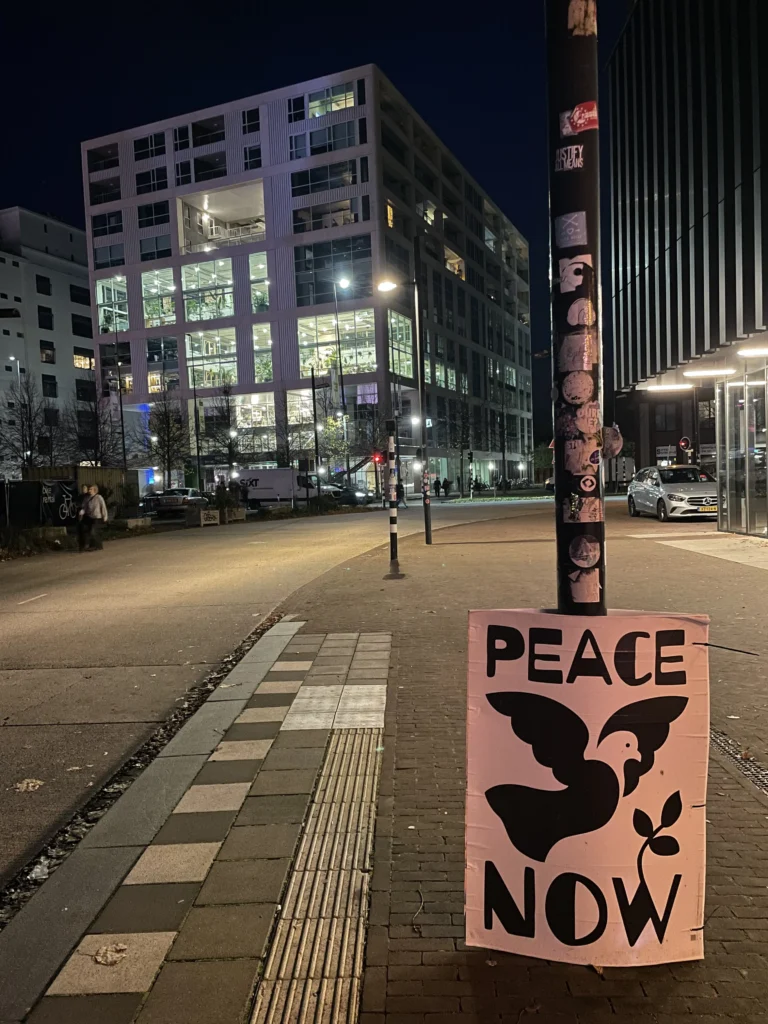
Gwenn Descamps
Gwenn Descamps is a visual artist and works as a props master on a well-known series in Marseille. Connected with engaged local communities, they wanted to embark on a humanitarian adventure to share their skills to human issues that are in line with their values.
Co-founder of Humanitarian Designers, Gwenn drives the development of the organisation and, more specifically, our communication activities.